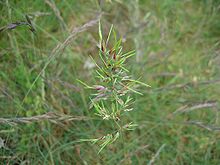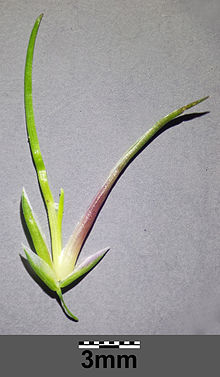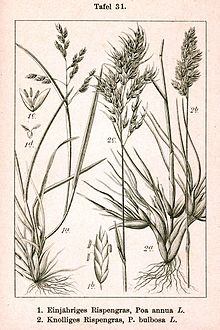Onion bluegrass
| Onion bluegrass | ||||||||||||
|---|---|---|---|---|---|---|---|---|---|---|---|---|

Onion bluegrass ( Poa bulbosa ) |
||||||||||||
| Systematics | ||||||||||||
|
||||||||||||
| Scientific name | ||||||||||||
| Poa bulbosa | ||||||||||||
| L. |
The onion bluegrass ( Poa bulbosa ), also called bulbous bluegrass , is a plant species within the sweet grass family (Poaceae). This almost inconspicuous sweet grass is characterized by vegetative organs, so-called brood buds (bullbills), which often form in the spikelets of the inflorescences ("false viviparia ") and always at the base of the stalk with the involvement of the leaf sheaths (onion-like thickenings). The specific epithet (Latin) bulbosa refers to the basal thickening for onion.
description
Vegetative characteristics
The bulbous bluegrass is a wintering green, perennial herbaceous plant that reaches heights of 5 and 40 centimeters. It grows in clumps . The stalks, which are round in cross-section, are thin and grow upright, sometimes arching from the base. The stems are unbranched, two to four knots and smooth. The stem base is thickened like an onion by leaf sheaths, hence the name. The smooth leaf sheaths are purple in color, the upper ones are green. The inside is enlarged at the bottom and fleshy thickened. They form the bulbous, pear-like thickening at the base of the vegetative shoot, in which reserve substances are stored (brood buds).
The leaves are bare. The leaf blades are very narrow with a hooded tip. The lower leaf blades are 1 to 10 centimeters long and 1 to 2 millimeters wide, folded or open, very finely rough on the edges, otherwise smooth. They soon dry up and break off. The whitish-skinned or green, elongated and pointed ligule are up to 4 millimeters long.
Generative characteristics
The flowering period extends from March to July, depending on the geographical location. The upright, loose, finely branched paniculate inflorescence is ovoid to oblong with a length of 2 and 6 centimeters and a width of 1 to 2.5 millimeters. The panicle branches are ascending, hair-like and very finely rough. The stalks are between 0.3 and 3 millimeters long. The spikelets, which are multicolored in green, purple and gold tones, are ovate to broadly elongated, with a length of 2 to 6 millimeters and contain three to six flowers. They often produce leaf-bearing brood buds. The persistent and skin-margined glumes are 2 to 3 millimeters long, keeled and thinly pointed. They're rough on the keels. The lower ones are one to three-nerved, the upper three-nerved. The lemmas overlap. They are lanceolate to lanceolate-ovate. They are between 2.5 and 3.5 millimeters long, keeled, membranous and five-nerved. They have a thick trimming of long, wavy hair on the bottom. Shorter, wavy hairs are present on the marginal nerves and on the keels. The palea are as long as the lemmas and very finely hairy on the keels. The anthers are 1 to 1.5 millimeters long. The seeds are tightly enclosed by the lemmas.
The number of chromosomes is 2n = 14, 28, 42, 45 or 58.
ecology
The bulbous bluegrass is a hemicryptophyte .
The pollination is carried by the wind.
In addition to generative reproduction , the bulbous bluegrass has brood buds (bulbils) available for vegetative distribution and reproduction ( blastochoria ). After the above-ground parts of the plant have died, the basal onion-like brood buds that are no longer connected to one another and in which reserve substances are stored remain. You can be blown away by the wind. Each brood bud then forms the basis for a new plant. Furthermore, the tuberous bluegrass often has the “false viviparity”, similar to the alpine bluegrass ( Poa alpina ). After the flowering period, daughter plants form in the spikelets that do not develop from the seeds (viviparia), but from leaf-bearing brood buds. These young plants later fall to the ground or remain on the mother plant. The panicles bend down under the weight of the young plants, where they can take root directly.
Distribution and location
The bulbous bluegrass is widespread in Eurasia and North Africa. Its distribution area extends from Europe to northwestern China, from Macaronesia to the Himalayas and also includes the Capensis. In North to South America, Australia and New Zealand the species is a neophyte .
The bulbous bluegrass colonizes predominantly summer-dry, sometimes ruderally influenced, gappy dry and semi-dry lawns , on sandy and stony rain areas , walls, slopes and in sparse dry forests. Its focus is on warm and sunny, slightly shaded locations , often near the coast. It thrives on low to nitrogen poor, very dry and moderately acidic, mostly calcareous soils . It thrives in Central Europe in societies of the Sedo-Scleranthetea class, also the Festuco-Brometea class or the Polygonion avicularis or Cynosurion associations. In the Mediterranean region it occurs in societies of the class Thero-Brachypodietea.
The bulbous bluegrass is a half-light to full-light plant. Its ecological indicator values for the plant according to Ellenberg are: L = 8, T = 7, K = 7, F = 3, R = 5, N = 2, S = 0 .
Systematics
One can distinguish between two subspecies:
- Poa bulbosa subsp. bulbosa : In this subspecies, the lemmas between the nerves are hairy. It occurs in the whole area of the species.
- Poa bulbosa subsp. pseudoconcinna (Schur) Domin : The lemmas between the nerves are glabrous. It occurs from the mountains of the Balkan Peninsula to Hungary and Lower Austria.
literature
- Henning Haeupler, Thomas Muer: picture atlas of the fern and flowering plants of Germany . Ed .: Federal Agency for Nature Conservation (= The fern and flowering plants of Germany . Volume 2 ). Eugen Ulmer, Stuttgart (Hohenheim) 2000, ISBN 3-8001-3364-4 .
- Charles Edward Hubbard: Grasses. Description, distribution, use (= UTB . Volume 233 ). 2nd, revised and expanded edition. Eugen Ulmer, Stuttgart (Hohenheim) 1985, ISBN 3-8001-2537-4 (English: Grasses . Translated by Peter Boeker).
- Ernst Klapp , Wilhelm Opitz von Boberfeld : Paperback of the grasses . Recognition and determination, location and socialization, evaluation and use. 12th revised edition. Paul Parey, Berlin / Hamburg 1990, ISBN 3-489-72710-X .
- Hans Joachim Conert: Poa bulbosa . In: Gustav Hegi : Illustrated flora of Central Europe . 3rd ed., Volume I, Part 3, pages 687-690. Paul Parey Publishing House, Berlin, Hamburg, 1987. ISBN 3-489-52320-2
Individual evidence
- ↑ a b Erich Oberdorfer : Plant-sociological excursion flora for Germany and neighboring areas . 8th edition. Stuttgart, Verlag Eugen Ulmer, 2001. ISBN 3-8001-3131-5 . Page 223.
- ^ Rafaël Govaerts (ed.): Poa bulbosa. In: World Checklist of Selected Plant Families (WCSP) - The Board of Trustees of the Royal Botanic Gardens, Kew . Retrieved November 12, 2016.
Web links
- Poa bulbosa L., bulb bluegrass. In: FloraWeb.de.
- Onion bluegrass . In: BiolFlor, the database of biological-ecological characteristics of the flora of Germany.
- Profile and distribution map for Bavaria . In: Botanical Information Hub of Bavaria .
- Poa bulbosa L. In: Info Flora , the national data and information center for Swiss flora . Retrieved September 24, 2015.
- Distribution in the northern hemisphere.
- Thomas Meyer: Data sheet with identification key and photos at Flora-de: Flora von Deutschland (old name of the website: Flowers in Swabia )




